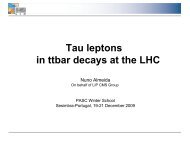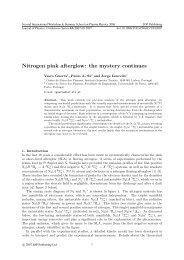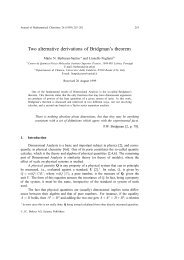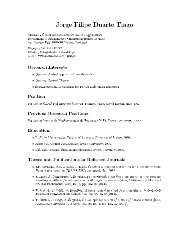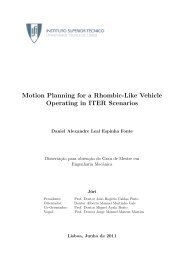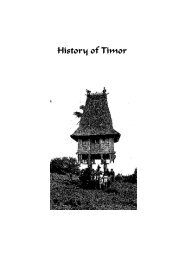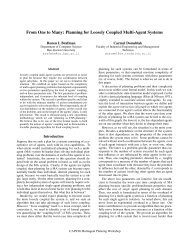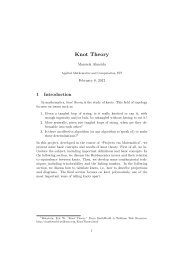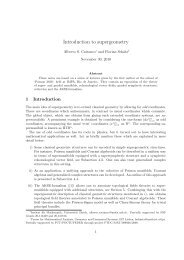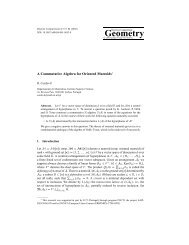Cournot Oligopoly and the Theory of Supermodular Games
Cournot Oligopoly and the Theory of Supermodular Games
Cournot Oligopoly and the Theory of Supermodular Games
Create successful ePaper yourself
Turn your PDF publications into a flip-book with our unique Google optimized e-Paper software.
130 RABAH AMIRBenhabib, J., <strong>and</strong> Radner, R. (1988). Joint Exploitation <strong>of</strong> a Productive Asset. New Jersey: Bell Laboratories.Bernheim, D., <strong>and</strong> Ray, D. (1983). “Altruistic Growth Economies, I. Existence <strong>of</strong> Bequest Equilibria.”IMSSS D.P. 419, Stanford University.Bernheim, D., <strong>and</strong> Ray, D. (1987). “Economic Growth with Intergenerational Altruism,” Rev. Econ.Stud. 54, 227–242.Bertsekas, D., <strong>and</strong> Shreve, S. (1978). Stochastic Optimal Control: The Discrete-Time Case. New York:Academic Press.Billingsley, P. (1968). Convergence <strong>of</strong> Probability Measures. New York: Wiley.Boldrin, M., <strong>and</strong> Montrucchio, L. (1986). “On <strong>the</strong> Indeterminacy <strong>of</strong> Capital Accumulation Paths,” J.Econ. <strong>Theory</strong> 40, 26–39.Brock, W., <strong>and</strong> Mirman, L. (1972). “Optimal Growth under Uncertainty: The Discounted Case,” J.Econ. <strong>Theory</strong> 4, 479–513.Budd, C., Harris, C., <strong>and</strong> Vickers, J. (1992). “A Model <strong>of</strong> <strong>the</strong> Evolution <strong>of</strong> Duopoly: Does <strong>the</strong> AsymmetryBetween Firms Tend to Increase or Decrease?” mimeo. Oxford University.Cyert, R. M., <strong>and</strong> DeGroot, M. H. (1970). “Multiperiod Decision Models with Alternating Choice asa Solution to <strong>the</strong> Duopoly Problem,” Quart. J. Econ. 84, 410–429.Dana, R.-A., <strong>and</strong> Montrucchio, L. (1991). “On Markovian Strategies in Dynamic <strong>Games</strong>,” preprint.Debreu, G. (1952). “Social Equilibrium Existence Theorem,” Proc. Nat. Acad. Sci. U.S.A. 38, 886–893.Dutta, P., Sundaram, R. (1990). “Stochastic <strong>Games</strong> <strong>of</strong> Resource Extraction: Existence Theorems forDiscounted <strong>and</strong> Undiscounted Models,” W.P. No. 241, Univ. <strong>of</strong> Rochester.Harris, C. (1985). “Existence <strong>and</strong> Characterization <strong>of</strong> Perfect Equilibrium in <strong>Games</strong> <strong>of</strong> Perfect Information,”Econometrica 53, 613–628.Harris, C., <strong>and</strong> Vickers, J. (1987). “Racing with Uncertainty,” Rev. Econ. Stud. 54, 1–21.Hellwig, M., <strong>and</strong> Leininger, W. (1987). “On <strong>the</strong> Existence <strong>of</strong> Subgame-Perfect Equilibrium in Infinite-Action <strong>Games</strong> <strong>of</strong> Perfect Information,” J. Econ. <strong>Theory</strong> 43, 55–75.Hellwig, M., <strong>and</strong> Leininger, W. (1988). “The Existence <strong>of</strong> Markov-Perfect Equilibrium in <strong>Games</strong> <strong>of</strong>Perfect Information,” SFB 303, No. A-183, Universität Bonn.Kall, P. (1986). “Approximation to Optimization Problems: An Elementary Review,” Math. Oper. Res.11, 9–18.Levhari, D., <strong>and</strong> Mirman, L. (1980). “The Great Fish War: An Example Using a Dynamic <strong>Cournot</strong>Nash Solution,” Bell J. Econ., 322–344.Lane, J., <strong>and</strong> Leininger, W. (1986). “Price-Characterisation <strong>and</strong> Pareto-Efficiency <strong>of</strong> Game-EquilibriumGrowth,” Z. Nationalökonomie/J. Econ. 46, 347–367.Leininger, W. (1986). “The Existence <strong>of</strong> Perfect Equilibria in a Model <strong>of</strong> Growth with Altruism betweenGenerations,” Rev. Econ. Stud. 53, 349–367.Majumdar, M., <strong>and</strong> Sundaram, R. (1991). “Symmetric Stochastic <strong>Games</strong> <strong>of</strong> Resource Extraction:Existence <strong>of</strong> Nonr<strong>and</strong>omized Stationary Equilibrium,” in Stochastic <strong>Games</strong> <strong>and</strong> Related Topics(Raghavan et. al., Eds.). Dordrecht: Kluwer.Maskin, E., <strong>and</strong> Tirole, J. (1988a). “A <strong>Theory</strong> <strong>of</strong> Dynamic <strong>Oligopoly</strong>. I. Overview <strong>and</strong> Quantity Competitionwith Large Fixed Costs,” Econometrica 56, 549–569.Maskin, E., <strong>and</strong> Tirole, J. (1988b). “A <strong>Theory</strong> <strong>of</strong> Dynamic <strong>Oligopoly</strong>. II. Price Competition, KinkedDem<strong>and</strong> Curves <strong>and</strong> Edgeworth Cycles,” Econometrica 56, 571–599.Milgrom, P., <strong>and</strong> Roberts, J. (1990). “Rationalizability, Learning <strong>and</strong> Equilibrium in <strong>Games</strong> withStrategies Complementarities,” Econometrica 58, 1255–1278.




